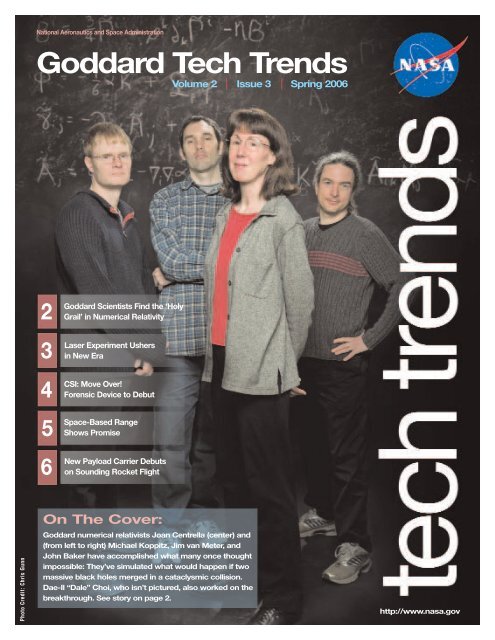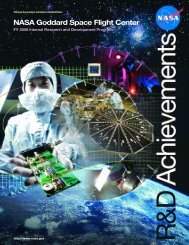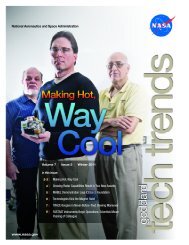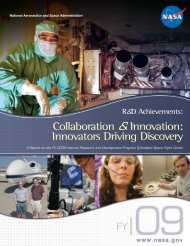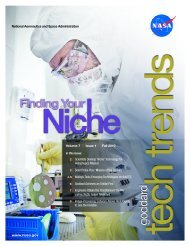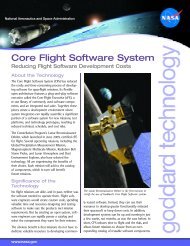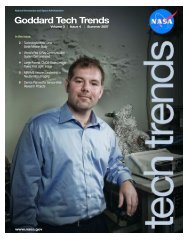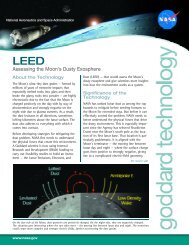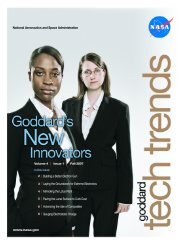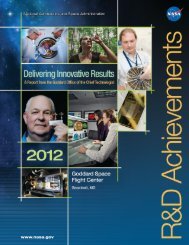Goddard Tech Trends - NASA's Goddard Technology Management ...
Goddard Tech Trends - NASA's Goddard Technology Management ...
Goddard Tech Trends - NASA's Goddard Technology Management ...
You also want an ePaper? Increase the reach of your titles
YUMPU automatically turns print PDFs into web optimized ePapers that Google loves.
National Aeronautics and Space Administration<br />
<strong>Goddard</strong> <strong>Tech</strong> <strong>Trends</strong><br />
Volume 2 Issue 3 Spring 2006<br />
2<br />
3<br />
4<br />
5<br />
6<br />
<strong>Goddard</strong> Scientists Find the ‘Holy<br />
Grail’ in Numerical Relativity<br />
Laser Experiment Ushers<br />
in New Era<br />
CSI: Move Over!<br />
Forensic Device to Debut<br />
Space-Based Range<br />
Shows Promise<br />
New Payload Carrier Debuts<br />
on Sounding Rocket Flight<br />
Photo Credit: Chris Gunn<br />
On The Cover:<br />
<strong>Goddard</strong> numerical relativists Joan Centrella (center) and<br />
(from left to right) Michael Koppitz, Jim van Meter, and<br />
John Baker have accomplished what many once thought<br />
impossible: They’ve simulated what would happen if two<br />
massive black holes merged in a cataclysmic collision.<br />
Dae-Il “Dale” Choi, who isn’t pictured, also worked on the<br />
breakthrough. See story on page 2.<br />
http://www.nasa.gov
02<br />
Finding the Holy Grail<br />
<strong>Goddard</strong> Scientists Discover What Happens When Black Holes Merge<br />
<strong>Goddard</strong> <strong>Tech</strong> <strong>Trends</strong><br />
A team of <strong>Goddard</strong> scientists has found the “holy grail”<br />
of numerical relativity by simulating what happens<br />
when two massive black holes merge in a cataclysmic<br />
collision, which scientists describe as second only to<br />
the Big Bang as one of nature’s most powerful and<br />
energetic events.<br />
Using sophisticated numerical codes, the team has calculated<br />
the shape of the resulting gravitational waves<br />
that would radiate in all directions, much like the<br />
ripples that happen when a stone is thrown into a<br />
pond. Although Einstein predicted the existence of<br />
gravitational waves in his Theory of General Relativity,<br />
no one has directly detected them yet. And until now,<br />
no one has calculated what these waves might look<br />
like in a science called numerical relativity, said Joan<br />
Centrella, Chief of the Gravitational Astrophysics<br />
Laboratory and principal investigator on the study.<br />
Now that Centrella and her team have demonstrated<br />
the waveforms, scientists have the means to test<br />
Einstein’s theories under extreme gravitational fields.<br />
This will benefit NASA’s proposed Laser Interferometer<br />
Space Antenna (LISA), a gravitational wave detector<br />
that the Agency hopes to fly the next decade (see story<br />
on page 8). Rather than simply inferring the existence<br />
of gravitational waves due to the motion of celestial<br />
bodies, LISA will use advanced laser interferometry to<br />
directly detect and measure them.<br />
Fundamentally New Knowledge<br />
“Our results will allow LISA to carry out tests of<br />
Einstein’s general relativity in a regime that’s never<br />
been accessible before,” Centrella said. “The waveforms<br />
we have produced give us the first look at what<br />
happens when black holes merge. This will give us<br />
fundamentally new knowledge about one of the most<br />
amazing theories ever conceived by the human mind.”<br />
Although Einstein proposed his theories 90 years ago,<br />
no one has ever solved the underlying equations with<br />
paper and pen due to their great complexity. “The only<br />
way to solve these equations is on a computer using<br />
the methods of numerical relativity, but this has proven<br />
difficult. In fact, a few years ago, some even said that<br />
numerical relativity was impossible because the computer<br />
codes were unstable. They crashed well before<br />
the black holes completed even a fraction of an orbit,”<br />
said Centrella, who used Internal Research and<br />
Development funding to begin the work at <strong>Goddard</strong>.<br />
More Work Remains<br />
Although her team’s work represents a major breakthrough,<br />
she concedes that more work still needs to<br />
be done. Relying now on <strong>Goddard</strong>’s Core Capabilities<br />
funding, a Beyond Einstein Foundation Science grant<br />
from NASA Headquarters, and the LISA project, she<br />
and her team are focusing on even more complex cal-<br />
Continued, Page 8<br />
This image shows the two massive black holes just before they<br />
merge. It was based on calculations performed by <strong>Goddard</strong><br />
numerical relativist Joan Centrella and her team.<br />
Using sophisticated computer codes, <strong>Goddard</strong>’s numerical relativists<br />
calculated the gravitational waves that would radiate out<br />
in all directions when two massive black holes merged.<br />
Illustration: Chris Henze, Ames Research Center<br />
http://gsfctechnology.gsfc.nasa.gov Volume 2 Issue 3 Spring 2006
Historic Test Brings Laser Spacecraft Ranging to a New Era<br />
<strong>Tech</strong>nology Slated for Use on the Lunar Reconnaissance Orbiter<br />
03<br />
An experiment in which an Earth-based observatory successfully<br />
exchanged laser pulses with the MESSENGER<br />
spacecraft while the two were millions of miles apart has<br />
helped to convince mission planners to include the same<br />
technology on the Lunar Reconnaissance Orbiter (LRO),<br />
which will launch in 2008 to map the lunar surface.<br />
The hope is that the highly precise laser-ranging technology<br />
demonstrated last spring with MESSENGER’s<br />
Mercury Laser Altimeter (MLA) will allow scientists to<br />
measure with centimeter accuracy the disturbances to<br />
LRO’s orbit around the Moon. With that information,<br />
they hope to learn more about the Moon’s well-known<br />
gravitational anomalies, which NASA first measured during<br />
the early days of the space program.<br />
“We proposed a subsystem for the Lunar Reconnaissance<br />
Orbiter and this experiment was the proof that it would<br />
work,” said Xiaoli Sun, MLA Instrument Scientist, referring<br />
to the record-breaking test that he and other MLA<br />
team members conducted from the <strong>Goddard</strong><br />
Geophysical and Astronomical Observatory in late May.<br />
“Our test with MESSENGER helped to convince us that<br />
we could do this with LRO.”<br />
Historic First<br />
The test between MESSENGER, which stands for<br />
MErcury Surface, Space ENvironment, GEochemistry<br />
and Ranging, and the <strong>Goddard</strong> observatory made headlines<br />
because it represented the first time scientists were<br />
able to conduct a two-way exchange of laser signals over<br />
vast distances in space. At the time, MESSENGER was 15<br />
million miles from Earth on its 6.6-year journey to<br />
Mercury, where it will map the planet’s surface.<br />
In addition to proving that such an exchange could<br />
occur at interplanetary distances, the test demonstrated<br />
its sub-nanosecond timing accuracy. It also calibrated the<br />
laser pointing and receiver bore sight, which was the<br />
principal reason for the test, Sun said.<br />
Long Time Coming<br />
NASA has long wanted to demonstrate the laser-ranging<br />
capability across deep space because of its widespread<br />
potential. In addition to determining orbital positioning<br />
needed for fundamental geophysical studies, the same<br />
laser technology can dramatically improve<br />
Continued, Page 6<br />
<strong>Goddard</strong> <strong>Tech</strong> <strong>Trends</strong><br />
<strong>Goddard</strong> technologists used this 1.2-meter Telescope Tracking Facility at the <strong>Goddard</strong> Geophysical and Astronomical<br />
Observatory to fire laser pulses to MESSENGER.<br />
Inset: A crane lifted MESSENGER out of the thermal vacuum chamber at the <strong>Goddard</strong> Space Flight Center after it completed<br />
5 weeks of rigorous tests to show that it could withstand the wide range of hot and cold temperatures that it would<br />
encounter on its journey to and mission around Mercury.<br />
Volume 2 Issue 3 Spring 2006<br />
http://gsfctechnology.gsfc.nasa.gov
04<br />
CSI: Move Over!<br />
<strong>Goddard</strong>-Developed Portable Forensic Analyzer Nears Completion<br />
<strong>Goddard</strong> <strong>Tech</strong> <strong>Trends</strong><br />
After 6 years in development, the<br />
portable forensic analyzer that<br />
<strong>Goddard</strong> scientists are developing<br />
with experts in academia, law<br />
enforcement, and criminal justice<br />
is expected to soon make its<br />
debut at a simulated crime scene<br />
to test whether the device can<br />
detect the presence of blood,<br />
gunshot residue, and other<br />
materials.<br />
Principal Investigator Jacob<br />
“Jack” Trombka, who began<br />
thinking of ways to apply NASA<br />
exploration technology to forensic<br />
science more than 30 years<br />
ago, has created a breadboard<br />
model of a portable X-ray fluorescence<br />
(XRF) system that’s<br />
similar in concept to those<br />
under development for planetary<br />
exploration.<br />
Equipped with silicon and cadmium-zinc<br />
telluride detectors, the system works by firing<br />
X-rays at an object. Atoms on the object’s surface<br />
then emit lower-energy fluorescent X-rays that are then<br />
detected and analyzed to determine their elemental<br />
composition. For instance, certain bodily fluids typically<br />
contain high concentrations of zinc, iron, and calcium,<br />
while gunpowder contains barium, antimony, and<br />
strontium.<br />
Telltale Signature<br />
The presence of these elements creates a telltale signature<br />
that investigators would recognize as potentially<br />
suspicious. That way, crime scene investigators would<br />
know immediately whether to collect the sample for<br />
further analysis or to leave it behind, Trombka said. The<br />
beauty of XRF, he added, is that the technology doesn’t<br />
destroy the sample it irradiates.<br />
The first demonstration is expected to take place in<br />
April at a special simulated crime scene to be set up at<br />
<strong>Goddard</strong>. Trombka said he plans to hold public demonstrations<br />
later.<br />
The project, which first began in 1998 under a<br />
Memorandum of Understanding with the Department<br />
of Justice, involves investigators from three universities,<br />
three state forensic laboratories, one district attorney’s<br />
office, and <strong>Goddard</strong>. However, discussions about developing<br />
such a device began 30 years ago when a good<br />
friend of Trombka’s — Sam Dash, the former chief<br />
<strong>Goddard</strong> Principal Investigator Jack Trombka (right) and two of his <strong>Goddard</strong> colleagues,<br />
Eric Young (left) and Sam Floyd (center), work on the portable forensic analyzer that<br />
will soon make its debut at a simulated crime scene.<br />
Watergate counselor — talked with him about using<br />
NASA know-how to advance the technology.<br />
Dash’s idea seemed like a good one, Trombka said.<br />
Both the forensic community and NASA’s planetaryexploration<br />
program would benefit from an analyzer,<br />
Trombka said. Now in its final stages of development,<br />
Trombka said the device is almost ready for commercialization<br />
and discussions have begun with potential<br />
manufacturers.<br />
“This Has Been Fun”<br />
One of the project’s challenges, he said, was developing<br />
a system that manufacturers could sell at relatively<br />
inexpensive prices. “Another question we had to consider<br />
was how to design a system so that it could be calibrated<br />
or even repaired remotely,” Trombka said. “We<br />
tried to keep much of it digital so that problems could<br />
be isolated and repairs could be made in software —<br />
not hardware.”<br />
That’s where NASA’s experience helped, he said.<br />
Satellite instruments are built to be remotely calibrated.<br />
“I have to be honest,” Trombka said, referring to his 6<br />
years on the project. “This has been fun.” ◆<br />
Contact:<br />
Jacob.I.Trombka@nasa.gov or 301.286.5941<br />
http://gsfctechnology.gsfc.nasa.gov Volume 2 Issue 3 Spring 2006
Experiment Proves Feasibility of a Space-Based Range<br />
Development Could Reduce Flight Costs<br />
05<br />
A recent technology demonstration carried out on a twostage<br />
Terrier Improved Orion sounding rocket late last<br />
year has the potential to revolutionize the way that<br />
range-safety officers monitor and abort rockets as they<br />
make their ascent into the heavens, say technologists<br />
involved in the test.<br />
In late December, technologists flew the Space-Based<br />
Telemetry and Range Safety (STARS) experiment and<br />
successfully showed that NASA could use its Tracking and<br />
Data Relay Satellites (TDRS) to provide vehicleposition<br />
tracking data during ascent and over-thehorizon<br />
flight operations. It also proved that NASA could<br />
use the TDRS network to transmit flight-abort commands<br />
as the rocket made its way along its flight path.<br />
"...the purpose of this demonstration was to<br />
show the viability of using a<br />
space-based tracking system and bypassing<br />
the ground systems all together.”<br />
“Traditionally, range-safety officials have used radar from<br />
ground stations to track flight vehicles and ground-based<br />
command systems to abort a rocket’s flight should it<br />
veer off course.” said Steven Bundick, a project manager<br />
at the Wallops Flight Facility. “However, it’s become<br />
increasingly more expensive to staff and maintain these<br />
aging facilities and the purpose of this demonstration<br />
was to show the viability of using a space-based tracking<br />
system and bypassing the ground systems all together.”<br />
<strong>Goddard</strong> <strong>Tech</strong> <strong>Trends</strong><br />
In addition to reducing ground operation costs, the<br />
advent of a space-based range would require less communication<br />
and shorten launch-turnaround times, NASA<br />
officials say. A space range also would allow the Agency<br />
to launch multiple vehicles in a short period of time<br />
from any U.S. spaceport.<br />
Jointly developed by the Kennedy Space Center and the<br />
<strong>Goddard</strong> Space Flight Center’s Greenbelt and Wallops<br />
campuses, STARS was one of two experiments included<br />
in the maiden flight of Wallops’s new payload carrier, the<br />
Suborbital <strong>Tech</strong>nology Experiment Carrier. The payload<br />
carrier will be made available twice a year or as required<br />
(see related story on page 6).<br />
“This technology is an example of how Wallops continues<br />
to reduce costs and improve performance,”<br />
Bundick said. More tests of the range-safey system are<br />
planned. ◆<br />
Contact:<br />
Steven.N.Bundick@nasa.gov or 757.824.1424<br />
The two-stage Terrier Improved Orion rocket lifted off from<br />
the Wallops Flight Facility in late December carrying a new<br />
payload carrier and an experiment that demonstrated the<br />
viability of a space-based range.<br />
Volume 2 Issue 3 Spring 2006<br />
http://gsfctechnology.gsfc.nasa.gov
06<br />
<strong>Goddard</strong> <strong>Tech</strong> <strong>Trends</strong><br />
New Payload Carrier Debuts on Sounding Rocket Flight<br />
<strong>Tech</strong>nologists at the Wallops Flight<br />
Facility have developed a new sounding<br />
rocket payload carrier that they believe<br />
will help mature emerging technologies<br />
more rapidly because it offers researchers<br />
a chance to test their experiments in<br />
space at a fraction of the typical cost.<br />
Tested late last year aboard a two-stage<br />
Terrier Improved Orion rocket, the<br />
Suborbital <strong>Tech</strong>nology Experiment<br />
Carrier (Sub-TEC) payload consisted of<br />
two experiment sections and a suite of<br />
support instrumentation, including<br />
power, timing, telemetry, attitude sensors,<br />
and system components needed<br />
to recover payloads.<br />
“If you have an experiment that requires a flight test in<br />
the space environment and it will physically fit in one of<br />
the two experiment canisters, we can fly it for you at a<br />
fraction of the cost of a custom-designed payload on an<br />
orbital mission,” said John Hickman, who is responsible<br />
for technology development for NASA’s Sounding<br />
Rocket Program Office at Wallops.<br />
“We can do this by providing a standardized set of support<br />
systems, sealing them in specially designed modules,<br />
and reusing the hardware once it is recovered and<br />
refurbished,” he added. “Basically, we already have built<br />
80 percent of the payload and have it sitting on the<br />
shelf. As a result, we can fly experiment modules for<br />
Following the maiden flight of the new Suborbital <strong>Tech</strong>nology Experiment<br />
Carrier (Sub-TEC), engineers and technicians disassembled and inspected the<br />
payload’s telemetry system after Sub-TEC was recovered from the water.<br />
Everything was dry.<br />
NASA customers for about $3,000 to $5,000 per pound,<br />
depending on the complexity of the experiment.”<br />
During its maiden flight, Sub-TEC carried the Spacebased<br />
Telemetry and Range Safety (STARS) experiment<br />
(see related story on page 5) — a joint effort involving<br />
the Kennedy Space Center and <strong>Goddard</strong> — and several<br />
in-house new technology experiments for the sounding<br />
rocket program. ◆<br />
Contact:<br />
John.C.Hickman@nasa.gov or 757.824.2374<br />
Laser Spacecraft... Continued from page 3<br />
communications in deep space. The Mars Telecommunications<br />
Orbiter, which NASA cancelled last summer<br />
due to budget constraints, would have used lasers to<br />
transmit data between Earth and Mars at a rate of 1 to 30<br />
million bits per second, depending on how close the two<br />
planets were. Currently, the maximum data speed with<br />
microwave technology is about 100,000 bits per second.<br />
In addition, scientists can use laser-ranging techniques to<br />
track spacecraft in solar orbit. From these studies, they<br />
can study the Sun’s gravity and infer the internal structures<br />
of the planets.<br />
Until last spring, however, a successful demonstration<br />
eluded scientists. In 1992, laser pulses were successfully<br />
transmitted and detected by the camera onboard the<br />
Galileo probe while it was 4 million miles away.<br />
However, Galileo carried neither a laser transmitter nor a<br />
timing capability. <strong>Goddard</strong> scientists also attempted similar<br />
tests with the Mars Orbiter Laser Altimeter onboard<br />
the Mars Global Surveyor and the Laser Ranger on the<br />
Near Earth Asteroid Rendezvous mission, but bad<br />
weather and spacecraft scheduling problems shut down<br />
the experiments.<br />
Lunar Subsystems<br />
Since the successful demonstration, LRO mission planners<br />
have decided to install a small optical receiver that will<br />
receive laser pulses from ground stations on Earth. The<br />
time that it takes the laser pulses to travel from the<br />
ground station to LRO determines with centimeter precision<br />
the orbiter’s position. In comparison, conventional<br />
radio-frequency tracking techniques only can measure<br />
spacecraft position to several meters, Sun said.<br />
Knowing highly precise positional data can reveal much<br />
about the effect of lunar gravity on the spacecraft’s orbit.<br />
“Such studies are crucial for improving our ability to predict<br />
the spacecraft position,” Sun said. “That way we<br />
assure safer landings for human and robotic cargo in<br />
future exploration.” ◆<br />
Contact:<br />
Xiaoli.Sun-1@nasa.gov or 301.614.6732<br />
http://gsfctechnology.gsfc.nasa.gov Volume 2 Issue 3 Spring 2006
New High-Gain Antenna Speeds Up Data Delivery for Ballooncraft<br />
<strong>Tech</strong>nology Demonstrated on CREAM<br />
07<br />
Researchers who use balloons to carry their experiments<br />
to the upper-most reaches of Earth’s atmosphere now<br />
have the means to retrieve their data at greatly increased<br />
rates in near real-time — in sharp contrast to what was<br />
available to them before.<br />
The Wallops Flight Facility has developed a new highgain<br />
antenna that uses the Agency’s Tracking and Data<br />
Relay Satellite (TDRS) system to transmit scientific and<br />
housekeeping data in real-time at 100 kilobits per second.<br />
This represents a more than 10-fold increase over<br />
data rates previously achieved using omni-directional<br />
antennas.<br />
The 18-inch flat plate array antenna already has flown on<br />
the two Cosmic Ray Energetics and Mass (CREAM) payloads<br />
launched from McMurdo Station in Antarctica. The<br />
experiment, a joint effort involving several U.S. and foreign<br />
universities, measures the spectra of cosmic-ray<br />
nuclei from helium to iron. The most recent mission<br />
ended Jan. 15 after the balloon spent 28 days aloft.<br />
“The researchers got their data immediately and we<br />
were able to monitor our systems continuously and<br />
respond immediately” said Wallops Project Manager<br />
Linda Thompson, referring to the speed by which<br />
researchers received their data during CREAM 2. At 100<br />
kilobits per second, she likened the situation to what<br />
people experience when they migrate from dial-up to<br />
broadband.<br />
During the CREAM launch, data was transmitted to<br />
TDRS, which then sent it to White Sands, N.M. From<br />
there, it went to the Operations Control Center in<br />
Palestine, Texas, the Engineering Support Center at<br />
Wallops Island, Va., and on to the Science Operations<br />
Center at the University of Maryland in College Park.<br />
The antenna has a bright future, Thompson said. “It definitely<br />
could be used on aircraft.” Future enhancements<br />
will increase its data rate to upwards of 1200 kilobits per<br />
second. ◆<br />
Contact:<br />
Linda.D.Thompson@nasa.gov or 757.824.1072<br />
Brian.A.Corbin@nasa.gov or 757.824.1012<br />
<strong>Goddard</strong> <strong>Tech</strong> <strong>Trends</strong><br />
The high-gain antenna has flown on two Cosmic Ray Energetics and Mass (CREAM) payloads launched from McMurdo<br />
Station in Antarctica. The most recent mission ended Jan. 15.<br />
Volume 2 Issue 3 Spring 2006<br />
http://gsfctechnology.gsfc.nasa.gov
08<br />
<strong>Goddard</strong> <strong>Tech</strong> <strong>Trends</strong><br />
Black Holes... Continued from page 2<br />
culations related to black-hole mergers. Originally, her<br />
calculations focused on black holes with equal masses<br />
and no spin. However, in nature black holes do spin,<br />
and binary black holes are likely to have non-equal masses.<br />
“So, there is some real work yet to do,” she said. “But<br />
our recent work opens the way for this to happen.”<br />
Revealing Mass and Motion<br />
Much can be learned from gravitational waves, which<br />
occur when massive celestial objects move and disrupt the<br />
fabric of spacetime that surround them, Centrella said.<br />
Similar to visible light in that they both travel in waves,<br />
spreading outward from their sources, gravitational<br />
waves carry information about the mass and motion of<br />
the objects that created them. “In particular, the gravitational<br />
waveform provides a map of what the black holes<br />
are doing when they move through spacetime,” she<br />
added. “Even though we can’t see the black holes,<br />
which are deep inside the centers of galaxies, we can<br />
map their motions by observing their gravitational waveforms.”<br />
Much of what scientists know about gravity comes from<br />
experiments within the solar system, where the gravitational<br />
fields are relatively weak. These experiments confirmed<br />
Einstein’s basic premise that gravity is a universal<br />
force connecting all forms of mass and energy. This<br />
means that gravity should act the same throughout the<br />
universe; however, important questions remain unanswered<br />
— particularly in the area of how gravity behaves<br />
under extreme conditions, such as when black holes merge.<br />
Centrella and her team recently submitted their findings<br />
for publication in The Physical Review, a scientific<br />
journal. ◆<br />
Contact:<br />
LISA: Opening a New Window on the Universe<br />
NASA’s proposed Laser Interferometer Space Antenna<br />
(LISA) consists of three, pillbox-shaped spacecraft that<br />
will be placed more than 3 million miles apart in a triangle-shaped<br />
configuration to search for gravitational<br />
waves with 100 times greater precision than anything<br />
achieved before.<br />
Joan.Centrella@nasa.gov or 301.286.3966<br />
Expected to fly next decade, LISA will measure gravitational<br />
waves radiating out from binary-star systems,<br />
black holes in our galaxy, and mergers of massive black<br />
holes where distant galaxies have collided. Mission<br />
planners also hope to be able to detect gravitational<br />
waves generated by the Big Bang, the cataclysmic<br />
event that created the universe. ◆<br />
<strong>Goddard</strong> <strong>Tech</strong> <strong>Trends</strong><br />
<strong>Goddard</strong> <strong>Tech</strong> Tends is published quarterly by the <strong>Goddard</strong> <strong>Tech</strong>nology <strong>Management</strong> Office (Code 502) at the<br />
<strong>Goddard</strong> Space Flight Center in Greenbelt, Md. The newsletter describes technology developments at the<br />
Center and explains how they are helping NASA to achieve its missions. If you want more information about<br />
<strong>Goddard</strong> technology or the <strong>Goddard</strong> <strong>Tech</strong>nology <strong>Management</strong> Office, contact the Code 502 representatives<br />
below. If you wish to be placed on the newsletter distribution list, contact the editor.<br />
Peter M. Hughes<br />
Chief <strong>Tech</strong>nologist<br />
Code 502<br />
301.286.2342<br />
Peter.M.Hughes@nasa.gov<br />
Lisa W. Callahan<br />
Deputy Chief <strong>Tech</strong>nologist<br />
Code 502<br />
301.286.1212<br />
Lisa.W.Callahan@nasa.gov<br />
Lori J. Keesey<br />
Editor<br />
301.258.0192<br />
ljkeesey@comcast.net<br />
np-2006-2-752-GSFC<br />
http://gsfctechnology.gsfc.nasa.gov Volume 2 Issue 3 Spring 2006


